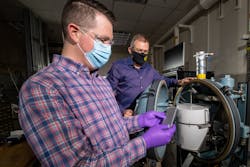Striving for a Safer Lithium Battery
This article appeared in Machine Design and has been published here with permission.
Solid-state batteries, currently used in small electronic devices such as smart watches, could be safer and more powerful than lithium-ion batteries for electric cars, storing energy from solar panels and other applications. However, several technical challenges stand in the way of solid-state batteries becoming more useful.
A team of researchers at Sandia National Laboratories is tackling one of these challenges—the assumption that adding some liquid electrolyte to improve performance would make solid-state batteries unsafe. After studying the issue, the team found that in many cases solid-state batteries with a little liquid electrolyte are safer than lithium-ion versions. It also discovered that solid-state batteries, once thought to be extremely safe, will put out dangerous amounts of heat if they short-circuit.
Solid-state batteries are somewhat like lithium-ion batteries. Both have lithium ions moving from one side of the battery to the other while electrons flow through a circuit to power the device. But in lithium-ion batteries, the liquid electrolyte helps the ions move quickly.
Unfortunately, current liquid electrolytes are flammable and can cause battery explosions or fires, especially when batteries are damaged.
In solid-state batteries, the liquid electrolyte is replaced by a solid electrolyte. It also helps lithium ions move quickly, but although ions move quickly in the solid electrolyte, they have a hard time moving to and from the electrolyte to the electrodes.
To speed up this “direct shuttling,” which shortens battery charging times speeds and improves performance, scientists have added a little bit of liquid electrolyte to the battery’s positive side.
“However, there has been a lot of controversy in the solid-state battery research community about the safety of adding liquid electrolyte to ‘grease the wheels,’” says Yuliya Preger, a Sandia battery reliability expert. “Some scientists say adding any amount of liquid electrolyte is unsafe. So, we did the calculations to see what the actual effects of liquid electrolyte.”
Determining Safety via Failure Modes
To determine just how safe a solid-state battery with a little liquid electrolyte would be, the team first calculated how much heat could be released in a lithium-ion battery, an all-solid-state battery and a solid-state battery with varying amounts of liquid electrolyte. All batteries tested had equivalent amounts of stored energy. Next, the researchers looked at three different failure modes and the heat that would be released in each type of failure.
“We started by determining just how much chemical energy is in the three kinds of batteries,” says John Hewson, a Sandia heat-release calculation expert. “There’s only so much energy that can be released which will heat up the battery a certain amount if there’s a chemical reaction.”
The first failure mode the team studied was what could happen is if the batteries caught on fire. In these cases, the researchers found that the solid-state battery with a little liquid electrolyte in it generated about one-fifth of the heat of a comparable lithium-ion battery depending on how much liquid electrolyte it had. The solid-state battery without liquid electrolyte didn’t produce any heat under this scenario.
The second failure mode was repeated charging and discharging causing the lithium metal to form a “spike” called a dendrite. These dendrites can puncture the membrane that keeps separates the two sides of the battery and creates a short-circuit. These failures led all three batteries to put off similar amounts of heat, which depended on how much lithium metal was in the batteries.
The third failure mode was the solid electrolyte breaking in a solid-state battery. This could happen if the battery was crushed or punctured or formed built-up pressure during operation. It lets oxygen from one side of the battery to react with lithium metal on the other side. In these cases, the solid-state battery without liquid electrolyte could reach temperatures near that of the lithium-ion battery, which the team found surprising.
One of the promises of solid-state batteries is that they are safe because the solid electrolyte is unlikely to break. But if it does, the temperature rise could be about as much as when lithium-ion batteries fail. This underscored the need to ensure the separating membrane be made too strong to fail.
The researchers then made similar calculations with other solid electrolyte materials and conducted experiments to validate the new and original calculations.
“We found if the solid-state battery has lithium metal, it could be dangerous, regardless of if it has liquid electrolyte or not,” says Bates. “There’s a definite trade-off between performance and safety, but adding a bit of liquid may greatly increase performance while only having a small effect on safety.”
“Solid-state batteries have the potential to be safer, and they have the potential for higher energy density,” said Alex Bates, a Sandia researcher. “This means, for electric vehicles, you could go farther in between charges, or need fewer batteries for grid-scale energy storage. The addition of liquid electrolyte may help bridge the gap to commercialization, without sacrificing safety.”

